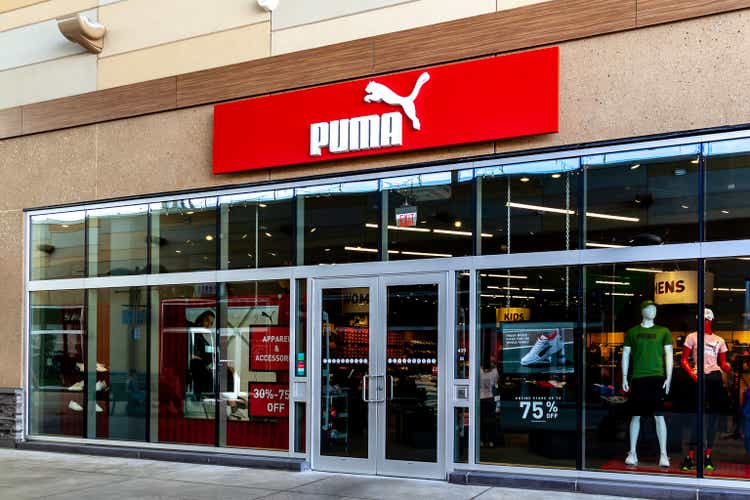Puma: Long-Term Story Intact

Summary
- Puma brand momentum is a positive catalyst and better supports the company's inventory management.
- In China, the company managed to outperform Adidas as well as Nike.
- Puma is still trading at a depressed valuation vs its closest peers. Our buy rating is then confirmed.
JHVEPhoto
After a few months since our last update and ahead of the Q1 2023 results on April 26th, here at the Lab, we decide to make some modest changes to Puma (OTCPK:PMMAF) forecasts and reiterate our overperforming rating. While Adidas (OTCQX:ADDYY) is currently trading on a trailing twelve month EV/sales at 1.58x compared to Puma at 1.08x, Wall Street is still discounting the company's medium-long term top-line growth and its short-term profitability with higher execution risk at Puma than Adidas, when the latest development has shown the complete opposite story. As a reminder, Adidas ended the Kanye West liaison, and after a few tumultuous weeks following the artist's social statements, from which the sportswear giant has finally distanced itself, the German company announced the partnership termination. The Yeezy brand will have a short-term negative impact of up to €250 million on Adidas' net profit and although revenues were up at constant currency, the Kanye West partnership and Chinese uncertainties prompted the management to once again downgrade the 2023 guidance. Here at the Lab, we believe that Puma is in better shape.
Why are we still confident in Puma?
- Aside from the valuation discrepancy, we should recall that Puma has a strong brand momentum in the European region;
- There are improving trends in China coupled with an acceleration in D2C compared to wholesale;
- Having checked the competitors (including Nike), while inventory remains elevated, here at the Lab, we are confident that warehouse pressure should be a relief in Puma's second half of the year as the company has taken care of its inventory level more efficiently than its closest peers;
- Since 2018, still looking at its comps, Adidas lost more market share in the Chinese region compared to any other brands. In detail, Adidas, Puma, and Nike lost 7.6%, 0.6%, and 1.3% respectively. So, Puma managed to outperform its competitors. Importantly to note is that Puma has a lower Chinese exposure (6% of top-line sales) and has a smaller deterioration in its points of sale with less damage on brand perception;
- Excluding currency development, our internal team is forecasting top-line sales growth at 12.5% with China at a plus 10% and strong growth in the EMEA region (up to 20%). Although offset by opex, we are still estimating a gross margin and a core operating profit decline at 7.2% of the company's turnover. This is also due to higher distribution expenses related to an unfavorable channel mix. On a yearly basis, we decide to leave unchanged our operating profit at €641 million and increase our EPS by 6% on lower minorities and finance charges;
- Even if we are not providing speculation, we believe that the new CEO Arne Freundt will focus the analyst call on franchise management, US distribution to reposition Puma's brand image, and re-engaging the Chinese clientele to be the next earnings growth story within the company. This should provide the necessary support that Wall Street needs to re-price Puma.
Conclusion and Valuation
Year-to-date, at the stock price level, Puma has been the worst-performing major sporting goods brand and we believe this is not justified. Investors' concerns are mainly related to inventory level, new partnerships, and Chinese exposure. While Adidas is seeking brand redemption, Puma is adapting its brand to the Chinese market with well-known brand ambassadors. With better inventory management thanks to a positive brand momentum, in 2022, Puma delivered a solid performance; however, the company is currently trading at the bottom of the margin cycle with a record discount versus its peers and its history. Puma's EV/EBITDA stands at <10x, while Nike and Adidas are at 27x and 18x respectively. Puma is also offering a higher dividend yield compared to Nike and Adidas (1.43% vs 1.12% and 0.43%). Here at the Lab, we believe that the company's valuation embedded the margin rebuild story and its low Chinese core operating profit which only reached 4% in 2022. Despite that, our top-line sales outlook is unchanged given the difference in the regional mix as well as our 7% EBIT margin for 2023. Therefore, given the brand momentum and its current execution, Puma should have a credible trajectory to a 10% EBIT margin as guided by the management team. Therefore, we reiterate our buy rating target. Major downside risks to Puma investment are 1) slowing turnover growth due to higher competition and macro demand, 2) higher input costs, 3) lower Chinese recovery, and 4) markdown pressure persisting.
Editor's Note: This article discusses one or more securities that do not trade on a major U.S. exchange. Please be aware of the risks associated with these stocks.
This article was written by
Analyst’s Disclosure: I/we have no stock, option or similar derivative position in any of the companies mentioned, and no plans to initiate any such positions within the next 72 hours. I wrote this article myself, and it expresses my own opinions. I am not receiving compensation for it (other than from Seeking Alpha). I have no business relationship with any company whose stock is mentioned in this article.
Seeking Alpha's Disclosure: Past performance is no guarantee of future results. No recommendation or advice is being given as to whether any investment is suitable for a particular investor. Any views or opinions expressed above may not reflect those of Seeking Alpha as a whole. Seeking Alpha is not a licensed securities dealer, broker or US investment adviser or investment bank. Our analysts are third party authors that include both professional investors and individual investors who may not be licensed or certified by any institute or regulatory body.
